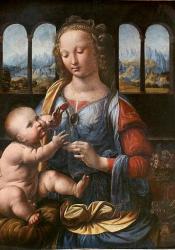Leonardo Da Vinci’s Madonna of the Carnation
Leonardo Da Vinci’s Madonna of the Carnation is currently displayed in the Alte Pinakpthek gallery in Munich, Germany. This rendition of the Madonna and Child was originally thought by art historians to have been painted by Andrea del Verrocchio; however, it is now agreed that Da Vinci created this piece. An oil painting on panel, the Madonna of the Carnation made use of a new medium of the Renaissance. This painting depicts Mary sitting with an exceedingly chubby and somewhat disproportionate baby Jesus on her lap. She holds a carnation, a symbol of healing, in her left hand. Da Vinci illuminates the faces of Mary and the Child but darkens the background through shadowing using the technique of chiaroscuro, which he later masters. The baby Jesus is looking upwards while Mary is looking down – neither are looking at the other. The folds and shadowing of their clothes are suggestive of depth, and the background of mountains and the blue sky adds to this feeling as the background becomes blurred in the distance, melding into the horizon.
Sources Used:
Feinberg, Larry J. “Sight unseen: vision and perception in Leonardo’s Madonnas: in the first of two articles on Leonardo da Vinci, Larry J. Feinberg explains how the artist’s interest in the way the eyes work influenced his realistic depictions of the Christ Child as a baby learning to see.” Apollo 159.509 (2204): 28-34. GALE. Web. 28 Feb. 2018.
“Madonna of the Carnation.” Wikipedia. Wikimedia Foundation, 24 Nov. 2016. Web. 28 Feb. 2018.
Image Courtesy of Wikipedia, page titled Madonna of the Carnation. Image is Public Domain.

